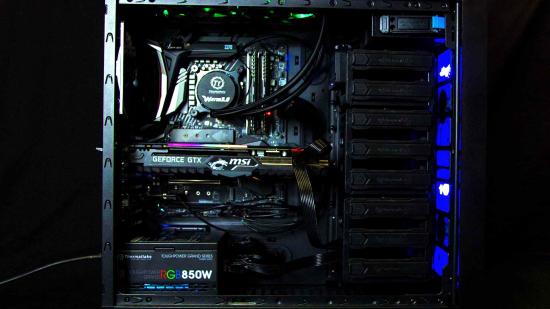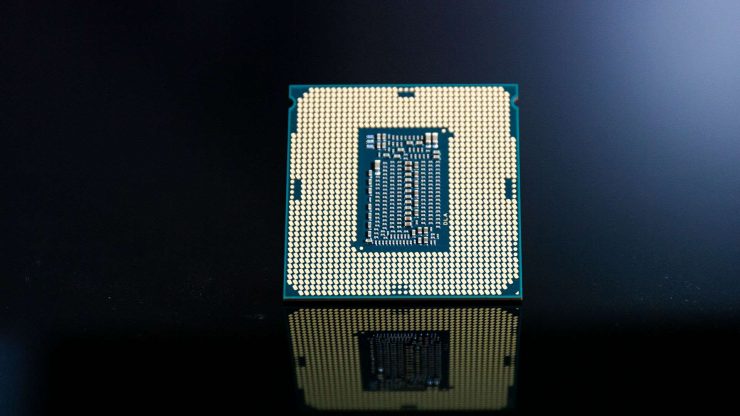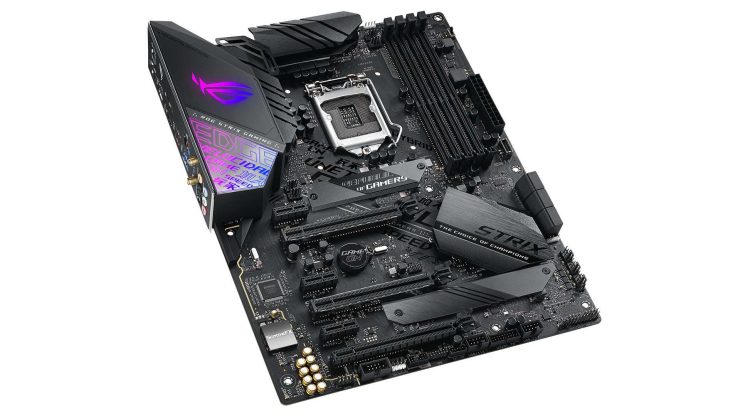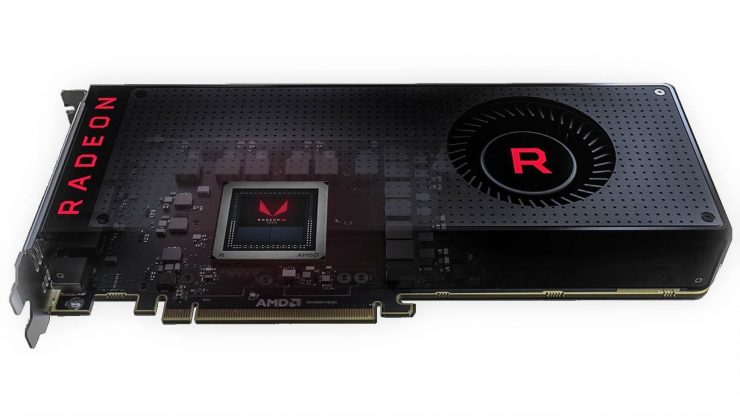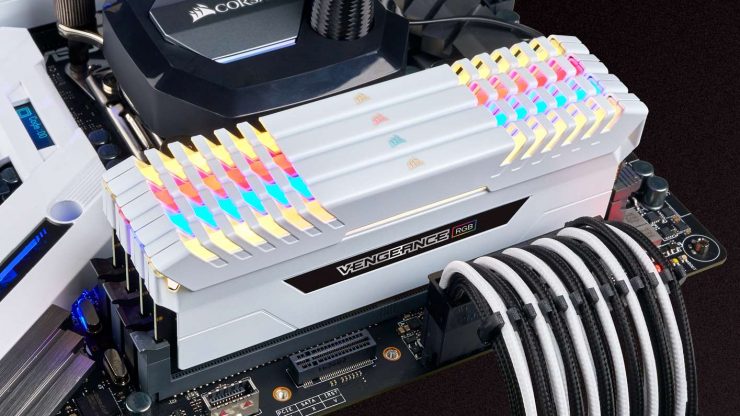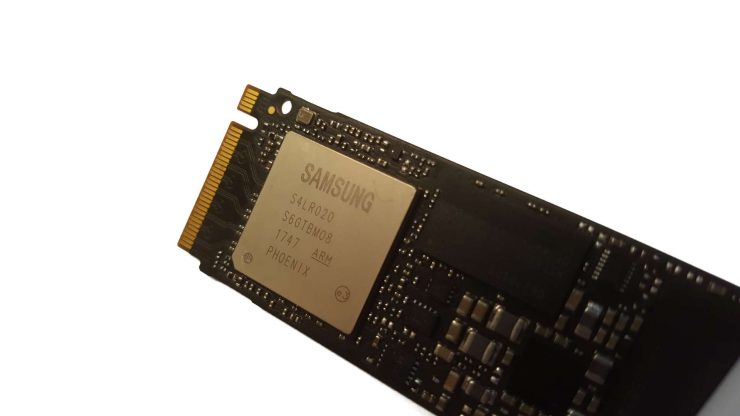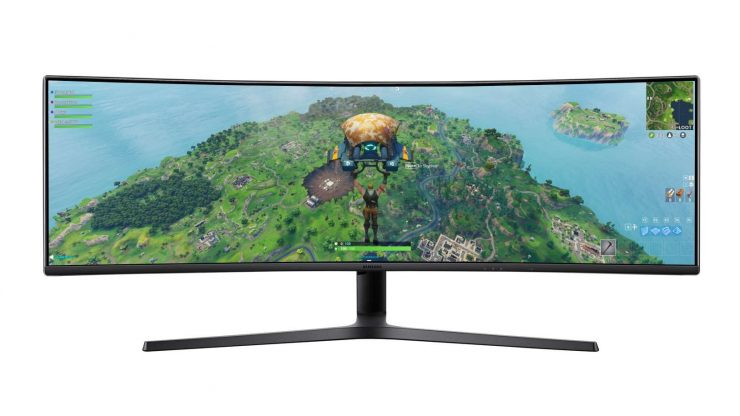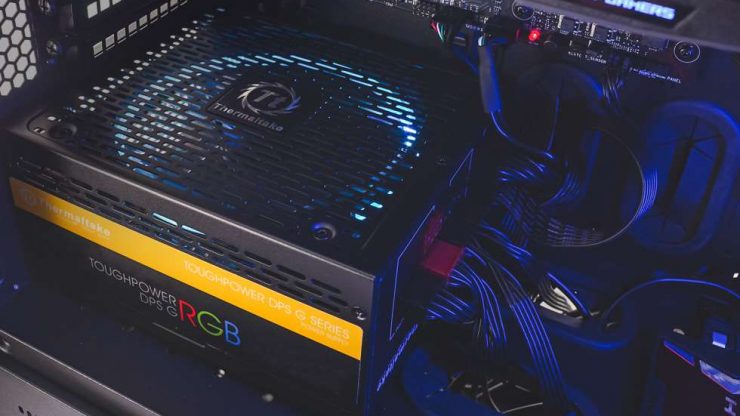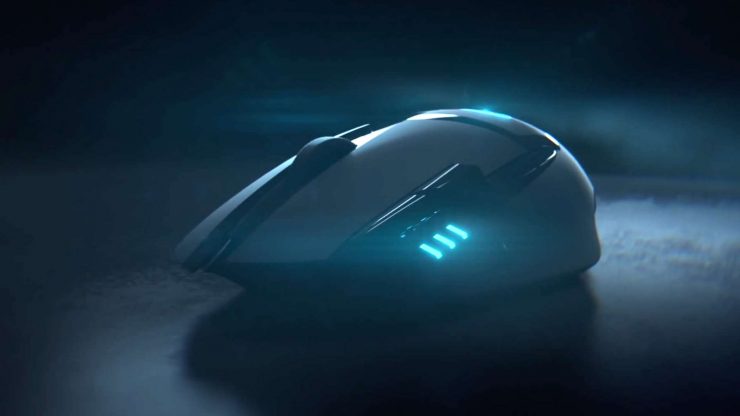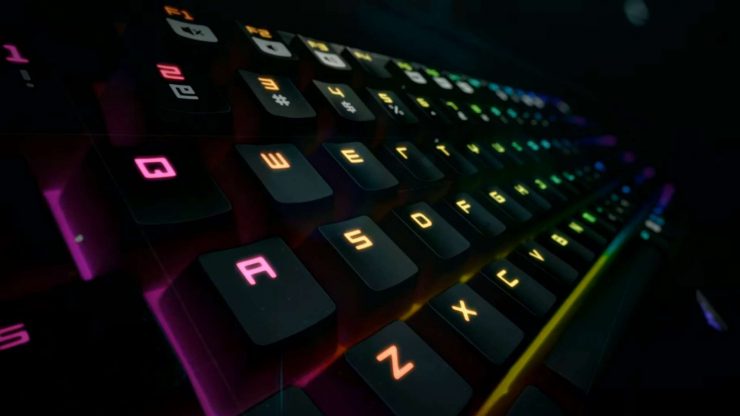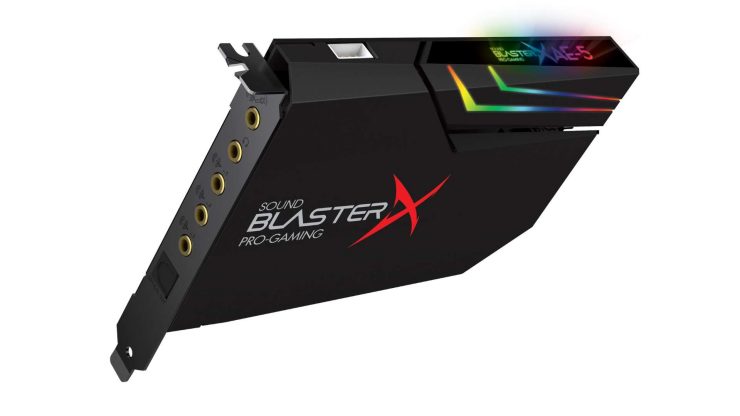Having difficulty telling your CPU from your GPU, your FLOPS from your ROPs? We’ve all been there. The world of gaming PCs can be full of jargon, but don’t worry, this is our mammoth, in-depth PC building bluffer’s guide – the PCGamesN glossary containing all the terms and acronyms you need to convince the world you know your silicon onions.
Technology develops pretty fast. If you don’t stop and look around once in a while, you could miss it. And the jumbles of letters jammed together to describe the latest hardware inside the best gaming PC develop even faster. Especially when manufacturers title their own products with complete disregard for standard naming conventions. We’re looking at you guys, Intel and AMD.
Maybe you need a new processor, but don’t know what you need inside it. Maybe you need to know what sort of board you can fit inside the best PC case. Or maybe you just want to pick up the best SSD for gaming and you’re tired of trying to figure your way through all the marketing jargon. Whatever your reason, we can guide you through the hardware terminology wilderness.
We’ve gathered the most important key terms here, for easy access, but clicking on the quick links to the side will take you to each section.
Processor
Think you’re ready to know how to overclock your CPU? Wondering what to do with all that excess liquid nitrogen? You need to learn to talk before you can run, so we recommend you start off with our handy guide to everything CPU. You might just be wondering how to pick a processor suitable for your needs. Understanding the technical terms of the best gaming CPU might mean you won’t try to perform a CPU upgrade that doesn’t fit in your motherboard socket, or accidentally drop a couple of grand on a 32-core server chip for your DOTA2 machine.
- CPU: Central processing unit. Also called a processor, or chip.
- Cores: The cores are the actual processing units within a CPU, with multiple cores making up a single processor.
- Threads: Cores can often run multiple operations at one time due to a technology called HyperThreading on Intel CPUs and Simultaneous Multi Threading (SMT) on AMD chips.
- Transistor: The transistor is the building block upon which modern technology is built. They are the tiny switches that provide the binary on/off of electricity that is the spine of computer programming.
- Nanometer: In silicon fabrication technology the transistors are now so small they’re measured in nanometers. In general terms the production scale, measured in nm, denotes the smallest transistor used in manufacturing a given chip, where the smaller the transistor, the less power it requires.
- Cache: Very speedy memory built into a CPU design. Different levels of cache can offer varying speeds and sizes, to improve wait times a CPU will store instruction queues and data on the processor rather than relying exclusively on system memory.
- Socket: The socket in which a CPU connects to a motherboard and subsequently other components within a computer. Commonly employed as LGA (land grid array), PGA (pin grid array), or BGA (ball grid array) designs to create the multiple contact points between chip and board.
- PGA, LGA, and BGA: PGA utilises pins on the CPU, LGA forgoes pins on the CPU in favour of pins within the motherboard socket, while BGA uses soldered balls to attach to the system, used within integrated systems so the CPU cannot be removed.
- Heat spreader: The heat spreader is the metal attached to the top of a CPU made to aid in thermal transfer away from the CPU cores to a discrete processor cooling component. It also helps avoid direct strain on the processor die, which are very fragile.
- Thermal compound: Often called thermal paste, chip grease, or CPU gunk (by Dave) this is a substance that aids in heat transfer between a processing unit and a cooler. These are often made of non-conductive materials to avoid shorting components when applied liberally.
- PCIe Lanes: The peripheral component interconnect express is the latest high speed bus connecting peripherals, such as graphics cards, to the CPU. They are made up of multiple lanes allowing simultaneous send and receive signals per lane. Graphics cards often use PCIe connections that make use of 16 lanes for increased bandwidth.
- Clock speed: The rate in which a processor completes an entire cycle. Processors are often measured in gigahertz (GHz), which is 1,000,000,000 cycles per second. Clockspeeds between different architectures cannot be compared without understanding the IPC, or instructions per clock.
- IPC: Instructions per clock is the average amount of instructions a processor can process per cycle. Different applications and processes will have varying IPC values.
- TDP: Thermal Design Power. The TDP reflects the heat generated by a component that a cooler will be required to dissipate. Measured in watts, although does not directly correlate to power consumption.
- Boost/Turbo clocks: Boost clocks represent the manufacturer’s maximum for clock speeds. Although this is not always the case, and can be exceeded with overclocking. Boost clocks allow a processor to perform better on certain cores while others are not in use and stay within rated TDP.
- Memory Channels: Dual-channel allows for, at least, two memory modules to utilise separate channels for increased bandwidth. These separate channels are often matching colours on a motherboard. Quad-channel allows for, at least, four memory modules to communicate on separate channels. Populating all channels allows for increased bandwidth.
- TJunction: This is the core temperature of your CPU, once this reaches the predefined TJunction Max value, the CPU will shut off to prevent damage. Before shutdown, a CPU will limit performance in an attempt to lower TJunction temps.
- Overclocking: Increasing clockspeeds beyond the initial product specification. Can be applied to graphics cards, memory and CPUs. Overclocked systems perform better, but in turn use more power and generate more heat.
- VRM: Voltage regulator module. Better voltage regulation allows for greater component lifespan and better overclocks.
- Resizable BAR: An open standard introduced in 2008 that allows the CPU to access all the GPU’s video memory directly, without the previous 256MB limitation. AMD’s version of this is called Smart Access Memory, or SAM for short, and was released alongside the Ryzen 5000 CPUs and Radeon RX 6000 GPUs in 2020.
Motherboard
The motherboard is a PC’s hub for connectivity and features. Make sure you check our best gaming motherboard guide, as if you go for the wrong one you can severely limit the features available to you, especially down the line when you look to add or update. If you aren’t sure if you’ll need more than one PCIe, or if you’ll need a water block fan header, then our guide to useful terms can help you out.
- Chipset: The chipset is a collection of integrated circuits on a motherboard. The chipset manages many of the connections with the CPU, such as, the input/outputs, LAN, storage, and audio, although many of these connections are now being built into the processors. The chipset also offers more PCIe lanes on top of those integrated into the CPU.
- Power connectors: Power connectors from the PSU must be connected to the motherboard. Most modern motherboards require a 24-pin EATX, and either a 4-pin ATX or 8-pin EATX CPU power connector, sometimes both for extreme overclocking.
- Socket: The socket in which a CPU connects to a motherboard and subsequent other components within a computer. Commonly uses a LGA (Land grid array), PGA (Pin grid array), or BGA (Ball grid array) design.
- Form Factor: EATX, ATX, Micro ATX, Mini ITX,listed from largest to smallest. Various size standards have been designed for extended, or cut-down, connectivity to fit different case designs. Mini ITX is the smallest of those listed, often with only a single PCIe slot and sometimes even notebook memory (SODIMM) slots rather than regular desktop DIMM slots. EATX offers an even wider ATX board, with more features and connectivity than an ATX motherboard.
- Fan headers: PWM and DC. PWM fans offer pulse width modulation, allowing for a finer speed control than DC fans, although requiring an extra connection on the fan header. PWM fans require 4-pin fan headers, while DC (on or off) require 3-pin. DC fans can also connect to 4-pin fan headers, with one spare pin left unused.
- PCI-e Lanes: The peripheral component interconnect express is the latest high speed bus connecting peripherals, such as graphics cards, to the CPU. They are made up of multiple lanes allowing simultaneous send and receive signals per lane. Graphics cards often use PCIe connections that make use of 16x lanes for increased bandwidth.
- SATA: Interface for storage drives, currently utilises the AHCI protocol with a hard bandwidth limit of 600MB/s on inputs and outputs across the interface.
- M.2: M.2 slots allow various sizes of M.2 drives, these are smaller form factor SSD drives that utilise either AHCI or NVMe protocols across either the slower SATA or speedier PCIe interfaces.
Graphics card
You might already know how to install a graphics card, but if you need to prove to your console friends that your gaming PC is, beyond a shadow of a doubt, better than their Xbox One X, then you’ll need to learn all about the best graphics cards and what makes them tick. Once you know all about your TeraFLOPS you can throw down knowledge on your friends until they buckle, or until you have no friends. Either way, you’ll have all learnt something.
- AMD FSR: AMD FidelityFX Super Resolution is an upscaler and a competitor to Nvidia DLSS. This means it renders your game at a lower resolution before upscaling it to your chosen native resolution, helping to boost fps. It is a little complicated, but you can learn all about it in our AMD FSR explainer page.
- GPU: The graphics processing unit is the central silicon chip of the graphics card that drives the computational power of the graphics card.
- Transistor: The transistor is the building block upon which modern technology is built. They are the tiny switches that provide the binary on/off of electricity that is the spine of computer programming.
- Nanometer: In silicon fabrication technology the transistors are now so small they’re measured in nanometers. In general terms the production scale, measured in nm, denotes the smallest transistor used in manufacturing a given chip, where – 7, 10, 14, 16, 22nm relates to transistor size the smaller the transistor, the less power it requires.
- FLOPS: The amount of floating point operations per second – useful for measure compute performance of a device. A teraflop is one million million operations per second.
- Video memory: The memory used on a graphics card to store information the GPU requires, and is working with, such as the frame buffer and textures.
- GDDR: The graphics double data rate (GDDR) is a type of memory, and the most common form, found on current generation cards. Utilises high clock speeds rather than a wider bus. Takes up a lot of space on the graphics card board. The current generations are GDDR5 and GDDR5X, with GDDR6 following.
- HBM: High bandwidth memory (HBM) has a much larger bus than GDDR memory although lower clockspeeds. Can be stacked to save space and latency and is built directly on the graphics processor itself. We are currently on the second generation, cleverly named HBM2.
- Cooler: The attached cooling solution, such as fans, heatsinks and heatpipes. Can be in a blower style with one fan as intake that expels air out of the case through the ports, or a open-air coolers, these fans circulate air within the case to cool graphics card components. Liquid cooling is also possible and can allow for higher clockspeeds.
- Stream processors: Roughly analogous to the cores of a processor, the stream processors in a GPU are simpler and traditionally calculate fewer operations per second. Modern GPUs have many more of these simple ‘cores’ inside them delivering their parallel processing power. Nvidia call them CUDA cores, while AMD sometimes denote them as GCN cores.
- Compute unit: These are groups of stream processors, also known as streaming multiprocessors (SMs) by Nvidia.
- GCN: AMD’s Graphics Core Next architecture.
- ROPS: A Render Output Unit (ROP) is one of the final stages in rendering a frame. This hardware component is responsible for bringing all the information together from various other stages of rendering into what will subsequently be displayed on-screen.
- TDP: Thermal Design Power – the amount of heat a component will output with an extensive load, under normal circumstances. Your graphics card cooler will be rated at cooling for the TDP of your graphics card.
- PCIe slot: The peripheral component interconnect express is the current high-speed slot on a motherboard a graphics card uses. Slots are rated to the amount of lanes a device plugged into them can access, with 16x being the maximum number of lanes on a third-gen slot, although graphics cards tend to have enough usable bandwidth at 8x.
- Power connectors: Most graphics cards require 6-pin, 6+2pin connectors or even multiples of either to supply them with enough extra power to function. The PCIe slot will, however, deliver 75W via the motherboard, which is why some GPUs and PCIe SSDs don’t require extra power.
- Memory bus: A wider bus offers more bandwidth for communication between the GPU and the video memory, although a smaller bus is commonly used with high clockspeeds.
- Clockspeed: Both the memory and GPU have different clockspeeds. These represent the speed at which a processor can run as the amount of instructions they can carry out per clock cycle.. Clockspeeds cannot be directly compared between different generations or brands of graphics cards.
- DirectX: A software developed by Microsoft to provide a unified way for developers to program for different graphics cards. The graphics API, or application programming interface, is the toolset used to build applications by developers that utilise hardware components, specifically for visuals and graphics rendering.
- OpenGL: Similar to DirectX, however this is open-source and available to all.
- Vulkan: An evolution of the OpenGL API, based on AMD’s discontinued Mantle API.
- DLSS: Deep learning super sampling is a proprietary technology made by Nvidia that uses AI to upscale images in real-time. It can even make games running N64-level 360p resolution look decent.
- Nvidia Reflex: A new proprietary platform that reduces end-to-end latency in compatible games that implement Nvidia’s SDK, like Fortnite and Call of Duty: Black Ops – Cold War. This works by further synchronising the CPU and GPU to reduce the render queue between them, making the click of your mouse reach the screen quicker.
- GPU Encoders: Nvidia NVENC, AMD VCE, and Intel Quick Sync are all H.264 encoders, utilising graphics hardware to encode the H.264/MPEG-4 codec rather than the CPU cores.
- Overclocking: Increasing clockspeeds beyond the initial product specification. Can be applied to graphics cards, memory and CPUs. Overclocked systems perform better, but in turn use more power and generate more heat.
- VRM: Voltage regulator module. Better voltage regulation allows for greater component lifespan and better overclocks.
- PCB: Printed circuit board. The PCB contains the connections for allowing the components of a system communicate and receive power.
- GPU Mining: Utilising the computational power of a GPU to carry out calculations that verify ‘blocks’ of transactional data for cryptocurrencies or other blockchain applications. If a GPU successfully parses the correct calculation, the miner will often be rewarded with a token with some monetary value.
- Cryptocurrency: These virtual coins aim to create a currency that is not dependent on any institution or central bank. They feature strong encryption – hence the name – and utilise verification of transfers and records across the network through the blockchain.
- Blockchain: A transactional-based technology that allows for a decentralised network to function securely. Cryptocurrencies and other blockchain applications utilise every node on a network to store the entire ledger of transactional or contractual information, which allows for strong fraud protection.
- Hashrate: The proficiency of a GPU to carry out the computational tasks required for mining. This can be on a per-card basis or the overall hashrate of a pool of mining rigs for a given cryptocurrency or blockchain application.
- Mining Difficulty: The difficulty increases as the network of miners hashrate increases and aims to control the creation of new cryptocurrency. This is why many cryptocurrencies eventually outgrow home mining setups.
Memory
So you’ve just picked up a set of the best gaming RAM, plugged it in and, good news! The computer starts up and nothing seems broken… but wait. Why is it running so much slower than what it says on the box?! You may feel ripped off, but before you send that angry email, take a look at our guide to memory jargon. Soon enough, you’ll be up and running with your memory purring along at advertised speeds, and you won’t even have to shout at customer service. Everybody wins.
- Speed: This is the clockspeed that the memory runs at. For gaming, memory speed is not a massively important factor, within reasonable speeds.
- DDR (Double data rate): Transfers data twice per clock, allowing for more data to be transferred. The current most common memory standard is DDR4, although DDR3 is still common among some PCs. DDR4 offers higher frequencies, greater bandwidth, and lower power consumption than DDR3 modules.
- XMP: An Intel-supported standard that can be turned on within the BIOS of XMP-supported motherboards to allow higher frequencies than usually supported out of the box. XMP profiles are preset by the manufacturers.
- Overclocking: Memory can be overclocked to reduce latency and increase frequencies. Memory may require higher voltages to keep stable under overclocking.
- Capacity: Memory is measured in Gigabytes (GB). 8GB is the lowest ideally recommended for gaming, although for more intensive applications such as video editing, more memory capacity will be helpful.
- ECC: Server standard memory, allows for self-checking and correcting of common issues and data corruption.
- Channels: Dual-channel allows for, at least, two memory modules to utilise separate channels for increased bandwidth. These separate channels are often matching colours on a motherboard. Quad-channel allows for, at least, four memory modules to communicate on separate channels. Populating all channels allows for increased bandwidth.
- Heat spreader: Memory often utilises a heat spreader to aid in thermal transfer of heat away from the memory and disperse it within the case.
Package memory format: For PC building, most common format is DIMM. Laptops and small form factor builds may use SODIMM memory instead, which is not as long as DIMM. - Latency: Measured by timings in a four digit format, for example: 15-15-15-36. The lower the numbers, the lower the latency.
Storage
If you aren’t sure why one SSD costs vast amounts more than another, and you can’t find a straight answer on the product page, then you’ve come to the right place. Knowing how to install an SSD can be simple enough, so long as you know the difference between them, such as the many shapes and sizes they come in. Not knowing the terms can leave you stranded with an SSD that cost you too much, or doesn’t offer you the performance boost you may have hoped for.
- HDD: Hard disk drives were the traditional storage medium on PCs for decades. The spinning platters store the data with a read arm scanning the surface to extract the information.
- SSD: Solid state drive uses non-volatile flash memory to store data, with much higher read and write speeds, but with no moving parts. It’s more expensive for lower capacities, but is (now) more reliable.
- Form Factor: 2.5″, mSATA, M.2. PCIe, BGA.
- SATA: Interface for storage drives, currently utilises the AHCI protocol with a hard bandwidth limit of 600MB/s on inputs and outputs across the interface.
- PCIe: Interface used for the fastest consumer storage drives – can use AHCI and NVMe protocols.
- AHCI: Protocol – slow, designed for HDD – up to 600MB/s.
- NVMe: Protocol – fast, designed for SSD – up to 3,500MB/s.
- Capacity: How much data can fit on the drive, measured in megabytes/gigabytes.
- NAND Flash: Type of non-volatile (retains information without power) memory cell used to store data, NAND refers to the type of logic gate used.
- SLC: A single-layer cell stores one bit per cell and is accurate, fast, and long lasting – 90,000 to 100,000 life cycles. It operates in broader temperature range, but is more expensive than other alternatives.
- eMLC: Enterprise multi-level cell is cheaper than SLC, delivers better performance and endurance compared to MLC – 20,000 to 30,000 life cycles.
- MLC: Multi-level cell stores multiple bits of data on one cell (usually two) – lower cost of manufacturing than SLC, but a shorter life cycle, at around 10,000 life cycles – though is still more reliable than TLC.
- TLC: Triple-level cell stores three bits of data per cell.It’s the cheapest to manufacture compared to MLC and SLC, but has a shorter lifespan compared to MLC – 3,000 to 5,000 life cycles.
- QLC: Quad-level cells store four bits of data per cell. As a result, manufacturers can create 33% higher capacity drives, but endurance and performance take a hit.
- 3D NAND: Stacked flash memory has higher densities than 2D/planar NAND at a lower cost per bit – Samsung developed it as V-NAND (vertical NAND) – and it offers reduced power consumption, potentially higher capacity within a smaller area, and – increased reliability. – Unfortunately it also has increased costs to manufacture.
- 2D/planar NAND: Traditional NAND used in SSDs – reliability fell as interference between cells increased with density.
- 3D XPoint: This is Intel and Micron’s non-volatile memory tech. It sits somewhere between your usual SSD NAND memory, and the DRAM found in your system memory, and offers incredibly low latency. It is still new to the SSD scene, yet Samsung are already offering an alternative in their V-NAND tech.
- Memory Controller: In charge of controlling read, write and erase cycles, wear levelling, garbage collection (clearing out-of-date data) and mapping. The memory controller is arguably the most important part of an SSD in terms of maintaining performance.
- Sequential read/write: How quickly the storage device can read/write a continuous block of data.
- Random read/write: How quickly the storage device can read/write random smaller blocks of data, we use 4kb files to benchmark the sort of file transfers an operating system will carry out during standard operation.
- IOPS: Input/output operations per second – random/sequential also applies.
Monitors
Need a 4K, ultrawide, G-Sync, 30Hz, TN, Quantum dot monitor? You most likely don’t, but it can be tricky to figure out what you actually need when searching for a monitor. Even if you’ve got the best gaming monitor already and you just want to know more about the tech, our guide is a great place to start your research.
- Resolution: The amount of pixels available to display an image on the monitor, traditionally measured in height and width.
- Size: The diagonal size, in inches, of the screen itself.
Refresh rate: How many times the monitor refreshes the image within one second. The standard is 60Hz, but it can be up to 240/480Hz. - Response times: How quickly the pixels change to the new information given to them – low response times leads to ghosting and motion blur.
- IPS: In plane switching offers the best colours and excellent contrast levels too, but can suffer from weaker black reproduction. Originally made by LG, they own the IPS branding, which has meant Samsung, and latterly AU Optronics, have had to create their own IPS-like tech – branded Plane to Line Switching (PLS) and Advanced Hyper Viewing Angle (AHVA) respectively. But all three essentially offer the same thing.
- VA: Vertical Alignment is the next step up, and is actually quite an advance over, TN. You get much better colours and the viewing angles are excellent too. VA panels also generally offer the best black levels too, even over IPS screens.
- TN: Twisted Nematic panels are the cheapest, and most common, type of display tech and, for the most part, it shows. Monitors using TN suffer from poor viewing angles (leading to weird colouration if you’re not sat directly in front), poor colour reproduction across the board, and a general washed-out look. Some, however, prefer them because of their quicker refresh rates and response times. But they’re wrong.
- G-Sync: Nvidia’s frame synchronising tech, which uses proprietary hardware to allow the monitor and GPU to sync up perfectly, only showing a new frame once the GPU has one ready in the buffer. Allows frames to be kept perfectly in sync regardless of the frame rate, but adds a premium onto monitors because of the extra Nvidia hardware module.
- FreeSync: AMD’s non-hardware based version allows the monitor and GPU to sync up, again only showing a new frame once the GPU has one ready in the buffer. It links in with DisplayPort’s Adaptive Sync technology making it essentially free for monitor makers to add into their displays.
- sRGB: Colour space standard used by professionals.
- Adobe RGB: Colour space standard used by professionals.
- OLED: Organic light-emitting diodes are self-emissive meaning the panels don’t require any backlighting, which means they can be incredibly thin. That also means they can display almost totally black screens when on, which means that, despite not reaching the peak luminance of others, they have incredible contrast levels. They can also deliver very fast refresh and response times too. They’re also very difficult (read: expensive) to produce so there are very few manufacturers able to make them.
- LED LCD: The traditional liquid crystal display uses a backlight made of many little LEDs to shine through the crystals and project the image.
Quantum dot: The quantum dot filter sits above the panel, widening the available colour gamut. Improves backlighting by removing need for white LED backlights – produces better colours, better contrast, higher brightness, and reduced power usage. - Aspect ratio: The aspect ratio is the relation of width to height and is shown as 4:3 or 16:9 for standard or widescreen aspect ratios, and 21:9 for the ultrawide aspect ratio.
- Ultrawide: Denotes much wider aspect ratios using increased width, such as 32:9 and 21:9.
- Nvidia Reflex Latency Analyser: New 360Hz G-Sync monitors are being endowed with a chip that allows users to measure PC and display latency with any mouse, however if you own compatible mice from Logitech, Asus, and Razer, then you can determine full end-to-end latency by plugging them directly into the monitor and the display into your PC.
The power supply is a massively understated component in PC building. It pushes voltage to the most delicate and intricate systems that can be turned into expensive paperweights by even the slightest surge of power. This is why it’s important to consider how to install a power supply, as knowing your 80+ Titanium PSU from your unbranded ebay knock-off can save you money on your electricity bills in the long run, and prevent complete system meltdown and disaster.
- PSU: Power supply unit.
- Rails: 12V, 5V, 5VSB, 3.3V – the connections that deliver power to components in your system.
- Wattage: Total power draw of your system must be within the maximum wattage of your PSU. Use a power draw calculator if need be to find out. More wattage will be required for overclocking, and higher quality PSUs will also deliver more stable wattage for overclocking too.
- 80+ Efficiency ratings: Products with 80+ rating can achieve 80% energy efficiency at 20%, 50% and 100% rated load. Bronze, Silver, Gold, Platinum, and Titanium improve on efficiency from 80% up to 94%.
- Ripple: Small, unwanted, residual periodic variation of the DC output of a power supply, derived from an AC source.
- Modular: All cables can be removed and attached as required, providing easier cable-tidying and increased airflow.
- Semi-modular: Cables that are always required in regular setups are attached permanently, only non-essential cables can be removed and reattached.
- Non-modular: All cables available are connected at all times, most often found on budget PSUs.
- Form Factor: ATX, SFX, TFX.
- Fan type: Fluid dynamic bearing, hydro dynamic bearing, sleeve bearing (most common), double ball bearing.
- Fanless 0db mode: Fan won’t start spinning until a certain load or temperature is reached. Reduces noise and fan use.
- Passive: A power supply that uses larger heatsinks to displace the heat instead of using fans, making it essentially silent. And hot.
Mice
Want to buy the best gaming mouse? It’s not necessarily worthwhile to go out and buy a laser mouse with 16,000 DPI just because it’s touted as the best by a sponsored esports master. Unless you are masquerading as an esports master, in which case, no one will believe you without some quality mouse knowledge, and that’s where our guide comes in.
- Laser sensor: These sensors bounce laser light off a surface to measure the distance travelled. It offers higher DPI ratings and works on any surface, but requires acceleration to translate the motion of the device to movement on the screen.
- Optical sensor: A cheaper, more consistent sensor, using infrared light. That means they need a mousemat for reliable use, but provide 1:1 tracking. Traditionally they offered lower DPI settings, but that is increasingly a thing of the past as the very best sensors are now optical based.
- DPI/CPI: Dots per inch and counts per inch, this is how the mouse measures how precisely it can track movement. Some mice can change DPI on-the-fly with specific buttons.
- Ambidextrous: Left-handed interchangeable support or entirely usable out of the box for either hand use.
- Switches: Mice can feature mechanical key switches for improved tactile feel and response.
- Claw grip: Someone who holds the mouse with the tips of their fingers and the palm is elevated.
- Palm grip: Someone who holds the mouse with their palm resting entirely on the rear of the mouse.
- 2.4GHz wireless: Wireless connection. Offers a more stable connection to Bluetooth alone.
- Bluetooth: Wireless connection. Offers a shorter, less stable connection to than radio-based wireless, but can often be connected to more devices.
- Sniper button: Quick DPI change button, found on FPS mice to slow down sensitivity to improve accuracy when aiming.
Keyboards
- Mechanical: A physical switch with actuation point on keypress. Possibly offers tactile feedback.
- Actuation point: This is the moment during a key’s travel that the switch is activated and the connection made. The amount of travel can vary greatly between different types of switch.
- Tactile: Keys that offer a physical click when actuated.
- Linear: Keys that offer no tactile feedback once actuated. Popular for gamers.
- Cherry MX: A popular manufacturer of mechanical switches.
- Compact: Just the essential keys required for typing.
- Tenkeyless: A regular keyboard with the number pad missing.
- 60%: Even smaller than a Tenkeyless model, removing both the numpad and arrow keys.
- Oversized: A keyboard with macro keys.
- USB pass-through: A USB hub port on the keyboard which acts as a standard PC-based USB port.
- Anti-ghosting: Ghosting is when the keyboard stops recognising key presses in certain combinations, anti-ghosting prevents this effect, although ghosting is an antiquated term.
- N-Key rollover: N-key rollover means any and all keys can be pressed and recognised at once. 6KRO is usually enough for even the fastest typists.
- Membrane: Electrical circuit reports key press through sheet of plastic instead of PCB – can sometimes offer some water resistance.
- Rubber Dome: Actuates a switch with a rubber dome within each key.
- Wrist rest: An ergonomic feature with some keyboards, offers improved comfort for long typing sessions.
- Macro keys: Programmable custom keys.
Audio
- Drivers: The component within headphones that converts the electrical signal into sound. The larger the driver, the more powerful the output, but that doesn’t necessarily equate to higher quality. Driver quality is key in creating the best sound quality.
- Amp: Power amplifier used to push a louder and better sound experience.
- DAC: Digital-to-analogue converter, this hardware converts the digital signal to analogue and utilise higher bitrate and sound quality.
- Impedance: Reducing impedance reduces the electrical resistance, therefore allowing higher volumes and lower power draw.
- Frequency response: A wider frequency range can make a difference in how the audio feels – lower frequencies will feel far more bass – higher frequencies will mean the sharper sounds are more audible.
- Operating principle: The two options are closed-back and open-back. The closed back is the more common principle used in gaming headsets, where the earcup is sealed to stop sound leaking out. This affects the audio, making it feel closer in to the ears, while open-back sets offer a more natural soundscape but the sound leaks out. These are more widely used in sound studios for audio monitoring.
